Resume mistakes occur when applicants don’t do enough research into the company and its standard hiring practices, so they include whatever they think is best in their document. Usually, that means writing about their professional background without considering what their employers want to see.
To learn more about the most common resume mistakes, we went straight to the experts: recruiters who read dozens of resumes daily. We asked them to share some of the errors they frequently encounter and explain how these can be avoided to boost your resume’s impact.
Key Takeaways
The most common resume mistakes include a lack of information on work experiences, grammatical errors, overly lengthy text, the use of buzzwords and clichés, and the absence of measurable results.
You can correct these mistakes by adhering to standard formatting practices, refining your content, and optimizing the structure to ensure it is readable and flows well.
To take your resume to the next level, make sure to proofread it, tailor it for the applicant tracking system, and keep it up to date.
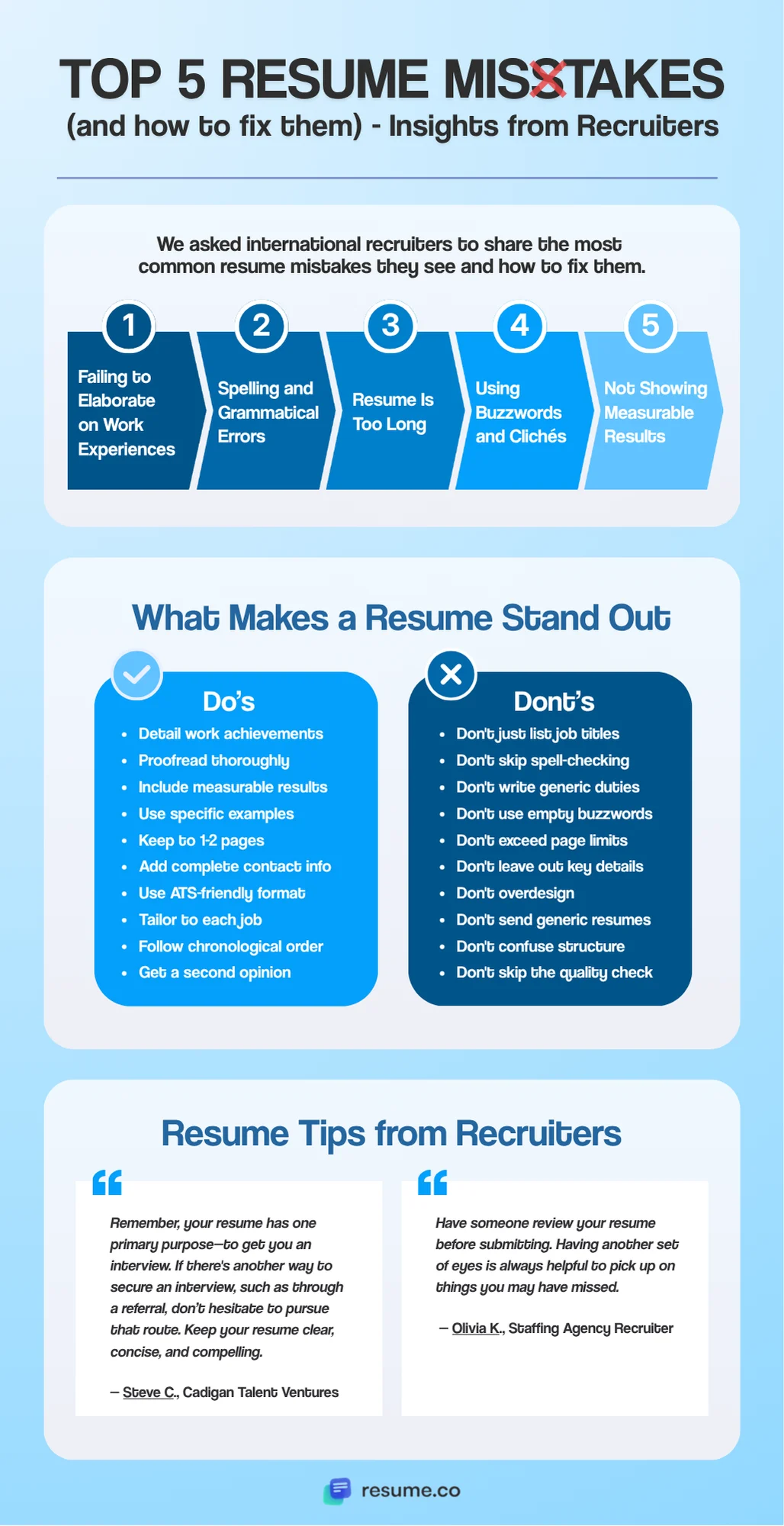
Top 5 Resume Mistakes Recruiters See All the Time
According to recruiters, the top five most common resume mistakes include failing to elaborate on work experiences, making grammatical errors, submitting a document that is over two pages long, using buzzwords and clichés, and failing to demonstrate measurable results.
Now that we’ve briefly listed frequent resume mistakes to avoid while applying, let’s get to the bottom of each one.
#1. Failing to Elaborate on Work Experiences
The number one mistake on a resume is, without a doubt, not providing enough information in the work experience section. An overwhelming majority of recruiters in our survey agreed on this, demonstrating that most job seekers don’t know how to effectively write about their professional background.
This isn’t too surprising; after all, many applicants believe that it’s enough to simply list their past job titles, companies, and periods of employment. Usually, their work experience sections look like this:
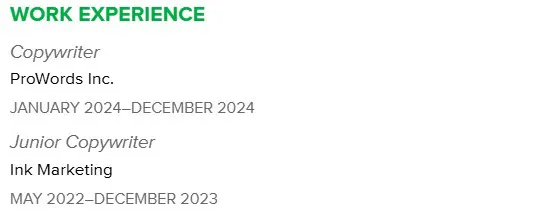
Obviously, this doesn’t say much about the applicant’s actual performance at their previous workplaces, so it has little value to the recruiters. Furthermore, a resume that lacks specific information appears generic and, therefore, loses some of its impact.
Instead, here is what your work experience section should look like:

As you can see, both past positions are much clearer now, as is the applicant’s performance and contribution. In fact, you should focus on the latter by talking about particular achievements and preferably corroborating your claims with numbers.
#2. Spelling and Grammatical Errors
Spelling mistakes on a resume can significantly impact hiring managers’ impression of you. This isn’t the case only for writing or other language-related jobs; practically every employer expects their employees to be professional in their work correspondence.
Yet, spelling and grammar errors leave the complete opposite impression, making you come across as unserious, uneducated, or careless. Plus, a lack of attention to detail can be a huge red flag and drastically lower your chances of getting hired.
For example, take a look at this resume summary that clearly wasn’t proofread:

Now, compare it to the following one, where the applicant double-checked their spelling and grammar:

It’s clear which one appears more professional and shows attention to detail, as mentioned in the summary. So, make sure to proofread your resume and use Grammarly or any other spellcheckers to be extra safe.
#3. Resume Is Too Long
Though you may think that including as much information as possible can boost your chances of getting hired, most recruiters don’t want to read lengthy resumes. For instance, the ones we surveyed pointed this out as one of the most commonly encountered mistakes that can negatively impact your ranking among candidates.
The issue with overly lengthy resumes is that they invariably contain unimportant information that does nothing but take up space. Your part-time student job is only relevant if you’re a recent graduate; otherwise, there’s no need to include it in your application.
A good rule of thumb is to stick to 1–2 pages and use the second page only if you have extensive, relevant experience. Ideally, you should be able to fit the most important information onto one page, as this is also convenient for recruiters.
#4. Using Buzzwords and Clichés
One of the most common resume mistakes is using buzzwords and clichés instead of specific, real-life examples. This is particularly prevalent among applicants with little work experience; they add buzzwords to compensate for a lack of actual achievements.
For example, using words like “creative,” “passionate,” “hard-working,” “professional,” or “driven” without any proof to corroborate them comes across as vague and generic. Most candidates will include these same descriptors, so you risk failing to stand out and thus losing an opportunity to receive an interview invitation.
Here is an example of two resume sections filled with buzzwords:
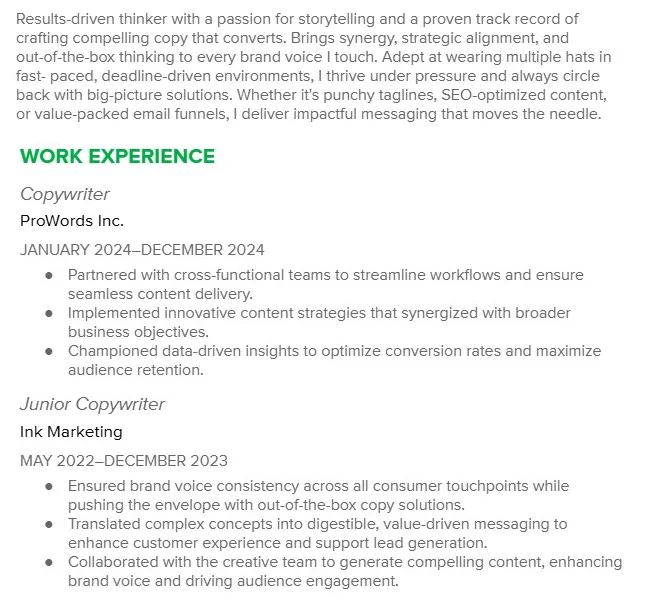
At first glance, this example may seem well-written and informative, but you’ll notice that it doesn’t say anything concrete upon closer inspection. It simply lists general responsibilities and traits related to a copywriter position, using buzzwords to sound more professional.
On the other hand, here’s a good example of the same two sections with far more concrete achievements and accomplishments:
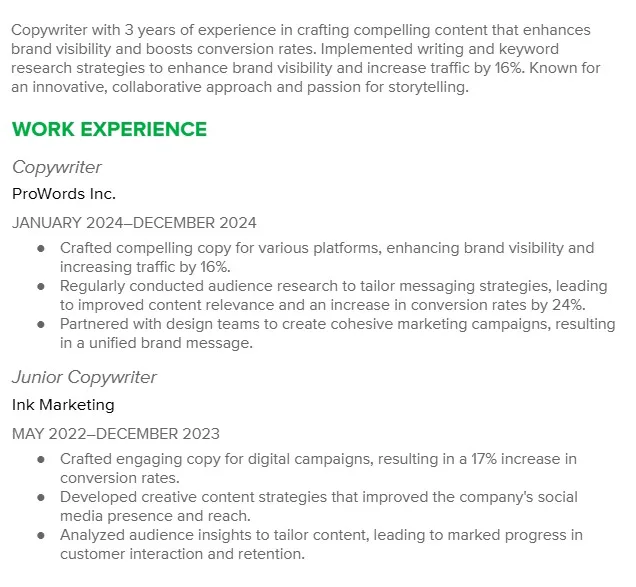
#5. Not Showing Measurable Results
Another common resume mistake recruiters in our survey pointed out is failing to showcase measurable results. Similar to the previous point, this makes your application seem generic and doesn’t clearly emphasize what sets you apart from the competition.
So, make sure to include measurable results, preferably with specific numbers and percentages. Add the size of the team you managed or the positive effect you had on your previous company’s productivity or growth. These will demonstrate what you can do for your new employer better than anything else on your resume.
That said, here is what two resume sections without measurable results look like:

On the other hand, here’s a far more effective approach:

Bonus: No Contact Information
Leaving out contact information makes it difficult, or even impossible, for recruiters to reach you. Remember, they often sift through hundreds of resumes and don’t have time to track down applicants who forgot to include their email, phone number, or LinkedIn profile.
Yet, despite this section playing such an important role, job candidates frequently forget to include it, according to the recruiters we’ve questioned. Here’s what a resume without contact information looks like:

The resume header seems empty, doesn’t it? Now, let’s take a look at the same resume but with contact information:
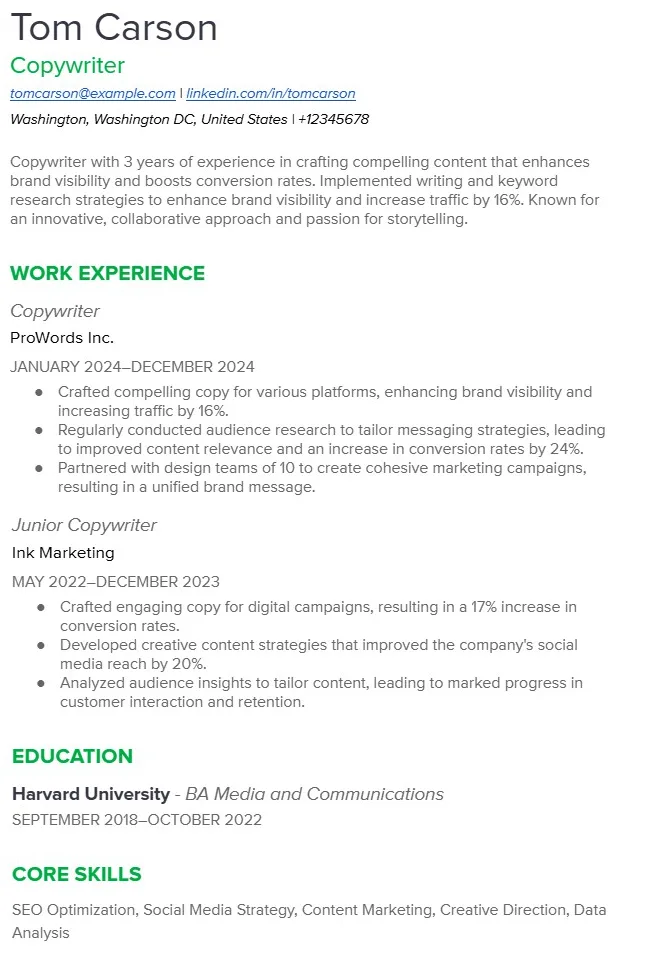
This one includes all the relevant contact details, making it far easier for the recruiter to reach out and, therefore, improving this candidate’s chances at landing their dream job.
4 More Common Resume Mistakes Applicants Make
The errors mentioned above are the most frequent and impactful, but they certainly aren’t the only ones recruiters encounter daily. In fact, here are some other common examples of resume mistakes that didn’t make it into the top 5:
4 Common Resume Mistakes
Poor formatting. Using an unprofessional font and paying little attention to the headings and margins can cost you a job. Proper formatting makes your document look visually appealing and helps it pass applicant tracking system (ATS) scans before it reaches the recruiter.
Including irrelevant personal information. Your age, nationality, marital status, and political views have no place on a resume and might even harm your chances of landing an interview. Sometimes the cause is discrimination, but other times, it’s simply your recruiter’s unwillingness to sift through unnecessary details to get to relevant parts.
Gaps in employment left unexplained. While your resume may not be a good place to elaborate on your employment gaps, you could use a cover letter for this purpose. Acknowledge the breaks in your career, explain why you’ve taken them, and demonstrate what you’ve learned during your time off.
No clear structure of the resume. Without a clear structure, your resume can appear confusing, unreadable, and chaotic. It’s best to follow the standard reverse chronological one that divides the content into sections and emphasizes the most recent work experience and education.
How to Fix Common Resume Mistakes, According to Recruiters

According to recruiters, the best way to fix common resume mistakes is to focus on improving the format and design, enhancing the content, and optimizing the structure.
Here are some concrete tips they’ve shared with us:
#1. Improve Resume Format and Design
Common resume formatting mistakes can easily be fixed if you pay attention to your text’s readability and visual appeal. Keep in mind the person who will read your resume; will they be able to locate the most important information at first glance? If so, you are on the right track.
However, according to recruiters, it’s not just the people reading that you need to worry about. Here is what one of our respondents had to say:
Recruiter Tip
“The format should be rich text with a modern, structured, and easy-to-read design in PDF format. It’s very important that the text can be read by an ATS.”
— Laura Sanchez, Talent Acquisition Specialist
So, the best course of action is to choose an ATS-optimized template that addresses the most common formatting concerns. However, if you’re making a resume from scratch, use a professional font (Arial, Calibri, Helvetica) and divide your content into paragraphs to create visual breaks.
Visual hierarchy is equally important; if the whole text looks the same, it won’t be interesting or easy to read. Headings written in a larger font typically help, as they stand out in the document and make it easier for recruiters to find the information they need.
#2. Improve Your Resume Content
Content is undoubtedly the most important part of your resume, so you need to make sure it’s informative, clear, and well-written. Even a perfect candidate may not land their dream job if they can’t properly represent their qualifications and background in a resume.
Here is what information your resume should include, according to a recruiter:
Recruiter Tip
“Include a concise overview of what each company you worked for does in terms of products, services, and industry. Clarify any vague job titles. Often, resume readers can have a preconceived notion of what certain titles entail. In your work history, clearly list your goals and activities to ensure there are no misconceptions.”
— Ken Sundheim, CEO at KAS Placement
Essentially, the goal is to be specific and detailed; that way, you set yourself apart from other candidates who certainly don’t have the same experiences as you.
However, there’s a fine line between being detailed and writing too much, and you need to tread it carefully. Ask yourself how specific information might benefit your standing in the job selection process and whether your employer will find it relevant. If not, it’s better to leave it out, even if it means writing less content.
#3. Optimize Resume Structure
Most recruiters agree that the best way to organize information in a resume is to put the most relevant details at the top. That allows hiring managers to see it right away and immediately understand your qualifications and background.
In other words, stick to the reverse chronological order when listing your experiences, starting from the most recent job position you’ve held.
The only exceptions to this rule are students, recent graduates, and applicants pursuing a new career path, as they might not have relevant experience to write about. In their cases, a functional resume or combined format is a much better choice.
Following this logic of putting the essential information on top, we might conclude that a resume summary is a crucial section that you must pay particular attention to. However, recruiters’ opinions are divided; some like to see it, while others say this:
Recruiter Tip
“Don’t forget, that word salad at the top is usually pretty redundant. Everybody has it, but in general, it’s a waste of real estate.”
— Gateway Staffing, Recruitment Agency
Ultimately, it’s up to you to decide whether you want to include this section. If you believe you can make it concise and impactful, go for it. Otherwise, it might be safer to let the rest of your resume speak for itself.
3 Tips From Recruiters on How to Make Your Resume Really Stand Out
The three tips from recruiters to make your resume really stand out include proofreading and quality control, tailoring for the applicant tracking system, and keeping your resume current.
Let’s take a closer look at each of these:
#1. Proofreading and Quality Control
As we’ve said before, grammar mistakes on a resume are very common and damaging to your application. They often occur due to a lack of proofreading; applicants submit their documents without re-reading them.
The solution is simple: check your document at least one more time before sending it to a recruiter. Reading it aloud might help, and if you’re not confident in your grammar, use proofreading software to help you correct your mistakes.
Also, consider the following to ascertain your resume’s flow and impact:
Recruiter Tip
“Have someone review your resume before submitting. Having another set of eyes is always helpful to pick up on the things you may have missed.”
— Olivia Krakowski, Staffing Agency Recruiter
#2. Tailoring for Applicant Tracking System
The applicant tracking system is frequently used to sort through job applications and select candidates who best fit the employer’s requirements. Nowadays, your resume often won’t reach the recruiter at all unless it first passes an ATS scan.
As a result, it’s crucial not to make resume mistakes that ATS scans can pick up on and to optimize your document according to the latest standards. Formatting and keywords play a particularly important role here; you should make sure your resume is readable and tailored to a specific job description.
Here’s what a recruiter has to say about this:
Recruiter Tip
“Incorporate keywords from the job description into your resume, but only where they genuinely reflect your experience and skills. This keeps your resume authentic while improving visibility with recruiters and applicant tracking systems.”
— Ivana Denić, International Recruiter
In other words, striking a balance between appealing to the ATS and impressing recruiters is crucial. If you focus on one and neglect the other, you risk either exaggerating your skills and experiences or not getting the application to the person who needs to read it.
#3. Keeping Your Resume Current
When applying to a new position, you shouldn’t use the same resume you’ve used years before. Such a document is undoubtedly outdated and doesn’t reflect the skills and experiences you’ve gained in the meantime.
So, to put it simply:
Recruiter Tip
“Follow accuracy around dates… Start with your current employers.”
— Seamus McQuaid, Deputy Recruitment Manager
Also, stay on top of hiring trends and practices, as they may change over time. For instance, being active on LinkedIn is now crucial for hiring, whereas that wasn’t the case to such an extent 10 years ago.
Create a Spotless Resume With Resume.co
If you want to avoid making common resume mistakes, try Resume.co and create a job-winning application within minutes. All you have to do is enter your information and choose a template; our professional resume builder will do the rest for you.
Final Thoughts
And there you have it—now you know what resume mistakes recruiters frequently encounter and want you to avoid. The most egregious one is, without a doubt, not elaborating on professional experiences, but others can significantly lower your chances of getting hired, too.
So, follow the recruiters’ advice and craft your resume carefully, paying attention to the language, information, formatting, and design. It may seem like there are too many factors to keep in mind, but it’ll all be worth it once you secure your dream job.
Resume Mistakes FAQs
#1. What are the top resume mistakes that disqualify applicants?
Common resume mistakes include: typographical or grammatical errors, using overly creative formatting that breaks ATS parsing, including inaccurate or inflated job details, and failing to tailor your resume for each job application.
#2. How can I avoid formatting mistakes on my resume?
Stick to a clean layout with standard headings like “Work Experience,” “Education,” and “Skills.” Use simple fonts (Arial, Calibri), bullet points, and avoid graphics, tables, or overly complex formatting that ATS software may not parse correctly.
#3. Is it okay to reuse the same resume for different job applications?
No, because it hurts your chances. Tailoring your resume for each role by incorporating relevant keywords and focusing on matching accomplishments shows personalization and improves ATS compatibility.


